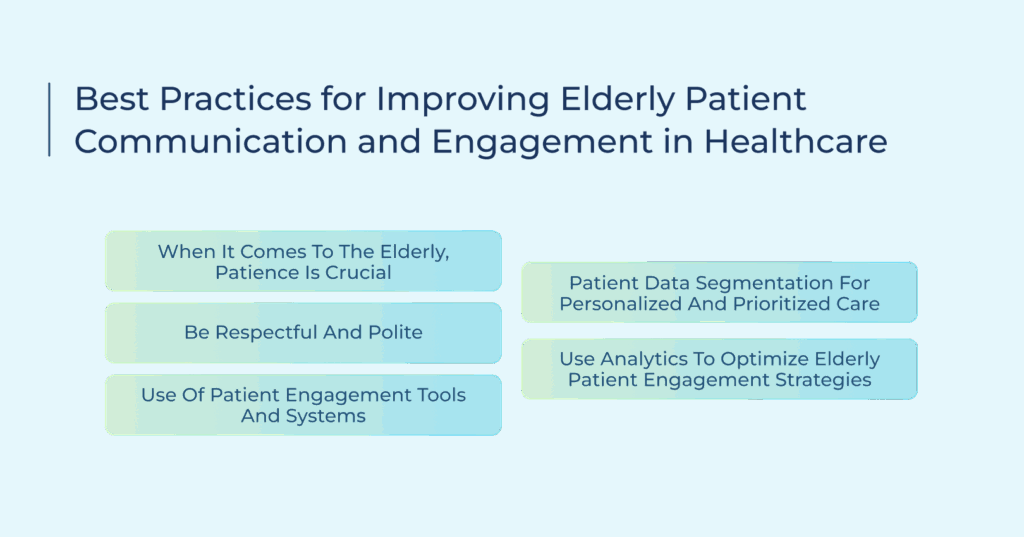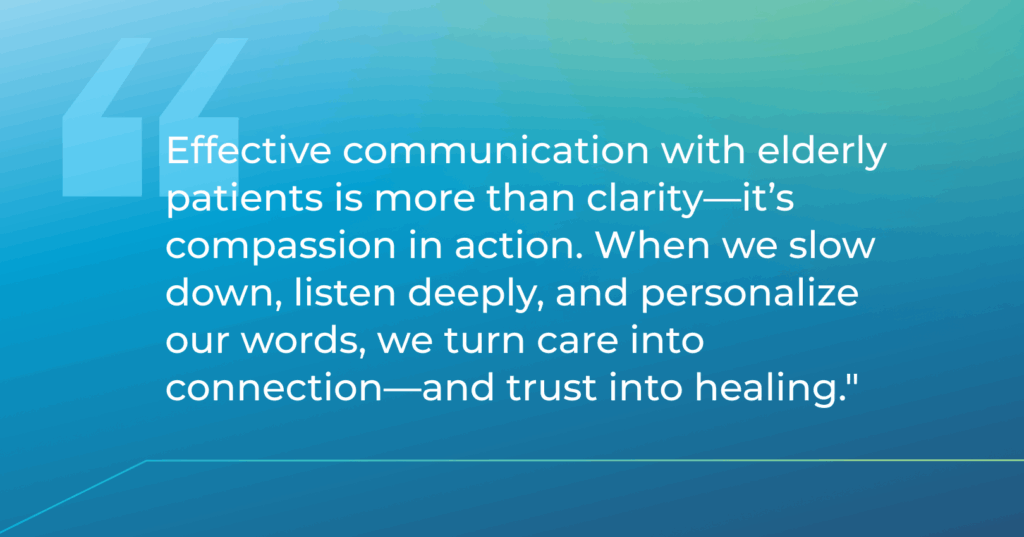Ever felt like a number in the healthcare system? The fact is that patients expect…

Effective Communication With Elderly Patients: Tips and Best Practices
Trust is everything in the healthcare sector. If your patients don’t trust you, they will never be open about their symptoms and health conditions. This becomes a bigger challenge when dealing with elderly patients. They require care teams to use a different communication approach, one that accounts for their age-related health deteriorations.
That’s why improving communication is essential for delivering quality care and building trust with older patients. Let’s see how.
Why Elderly Patients Need to be Communicated Differently in Healthcare
Age brings a new set of communication challenges for patients that healthcare teams cannot afford to overlook.
Patients struggling with hearing aids might feel embarrassed to ask their physicians to repeat themselves. Those with reduced vision might ignore their test results unless they are read out to them.
Memory issues further compound these problems as patients may forget clinical conversations after reaching home.
Then there are social and emotional factors (depression, loneliness) that play their respective roles, causing the elderly to either downplay their symptoms or ignore care completely.
This is the reason why medical professionals need to modify their communication approach towards older patients. They need to communicate using simpler terms, disregard complicated vocabulary, speak slowly, be patient, and create a comfortable environment for queries. Something as little as eye contact can also serve to secure the confidence and attention of an older patient.
Principles of Effective Communication With Elderly Patients
Here are 10 principles that provide clear steps to improve patient interactions and build trust through better communication.
1. Use Simple and Clear Language for Easy Understanding
Clear speech always helps elderly patients understand their health better. Make it a habit to use everyday words. Make each sentence small and clear with a friendly tone. This will put them at ease so that they can follow what you’re saying.
2. Avoid Medical Jargon as Much as Possible
As a rule of thumb, try to avoid using any medical terms or procedure names. If you must, choose common terms over medical lingo, like “broken bone” instead of “fracture”. In terms of procedures, break them down into parts for patients to understand with ease. This approach keeps patients engaged in their care decisions.
3. Elderly Patients Need Time to Process and Respond
Elderly patients often need time to process information. They are not as fast as younger adults. Hence, when speaking, slow down and pause after important bits. This gives them space to think and respond with questions. Don’t just keep stringing sentences. Chances are that you will lose your patience after the first few minutes.
4. Stick to One Topic of Discussion at a Time for Maximum Retention
Covering multiple subjects at once overwhelms patients and reduces comprehension. For example, start by discussing medication before moving to follow-up appointments. Complete each topic before starting the next. This method helps patients remember important details about their care.
5. Repeat the Important Instructions When Needed
You often have to repeat the same information to ensure your elderly patient has understood the important bits. Key details like dosage and warning signs to watch out for should be clearly and slowly restated. It’s good practice to use different words each time to reinforce the same message.
6. Encourage Patients to Ask Questions
As already noted above, elderly patients refrain from asking questions out of embarrassment. Hence, a warm, friendly approach can make all the difference by creating gaps in conversations where patients can be encouraged to ask questions. This is especially critical after explaining important information.
7. Using Visual Aid Where Helpful
Pictures, charts, and written materials are excellent ways of explaining key (or even somewhat complicated) information to elderly patients. Many of them learn better when they can see information alongside hearing it.
Use anatomical diagrams to show where problems occur or medication charts to display dosing schedules. Provide written summaries they can reference at home. Visual aids are how healthcare organizations make complex information more accessible to the elderly.
8. Use of Empathy to Connect Better
Note that elderly patients feel vulnerable about their health changes. You should validate their concerns by listening to them with genuine concern. Importantly, your body language and tone should reflect your concern. This is how you earn their trust and have them open up about symptoms that they might not share otherwise.
9. Involve Family Members and Caregivers When Appropriate
Involve family members or caregivers in discussions. Most elderly patients depend on support networks to make health choices and receive daily care. Family members may be able to help interpret information later and facilitate adherence to care plans. But always seek the patient’s consent before involving others in medical discussions.
10. Communicate Through Preferred Channels
It’s equally important to ask patients their preferred way of staying in touch. This is more than just asking their preferred contact method. You want to know how they access certain types of messages.
For instance, elderly patients seldom check their email, so there’s no point in sending appointment reminders over there unless stated otherwise.
Many older adults still prefer a phone call or a text message as it feels the most personal. Matching your message to their comfort zone can make all the difference in whether it’s received or ignored.
Best Practices for Improving Elderly Patient Communication and Engagement in Healthcare

Healthcare leaders understand how successful communication with elderly patients combines personal interaction with technology. It not only creates stronger patient relationships, but also better patient outcomes.
When It Comes to the Elderly, Patience is Crucial
Unlike young adults, elderly patients take time to process information. If you are rushing through a conversation, chances are that your patient has no clue about what you’re talking about. You’ll only end up creating more confusion and anxiety. Hence, be patient. Take the time it needs to have older patients grasp any medical instructions. This makes them feel valued and heard.
Be Respectful and Polite
This is not exclusive to just the elderly. All your patients deserve the same respect. This starts with speaking softly. If the patient is hard of hearing, don’t just start shouting. If the patient asks too many questions, show patience. Your body language shouldn’t reflect annoyance. That will only lead to poor patient experiences.
Use of Patient Engagement Tools and Systems
Modern patient engagement platforms like TeleVox use multi-channel messaging systems that use patients’ preferred communication methods, whether phone calls or text messages.
Automation further benefits elderly patients by taking their routines into account. For instance, sending medication reminders at the precise time when a patient has to take a pill holds more actionable value than a random alert. The key is offering multiple communication channels to match individual preferences.
Let’s also not forget about user-friendly interfaces. Patient portals for the elderly need to have larger fonts, simplified menus, and clear instructions. Overwhelming designs might look nice, but include a lot of noise for the elderly who are not that tech-savvy to find what they’re looking for. Hence, keep it simple.
Patient Data Segmentation for Personalized and Prioritized Care
Another good practice is to group elderly patients based on their real needs, like chronic conditions, risk levels, communication habits, and more. So high-risk patients receive more frequent and proactive monitoring. Providers can also use targeted education and support for groups of patients with the same conditions. It’s personalized, precision care that helps prevent hospital readmissions and wasted outreach.
Use Analytics to Optimize Elderly Patient Engagement Strategies
Healthcare organizations rely on technology to remove the guesswork from elderly patient communication. Your engagement data shows exactly which channels (phone, text, email, app) drive results.
Most patient engagement platforms can also track metrics to improve outreach. These range from appointment attendance and medication adherence to preventive care completion.
Compare these outcomes across different communication strategies to identify what works. For example, personal phone calls might generate better responses than automated messages for certain patient groups.
How Effective Communication Improves Outcomes for Elderly Patients
When healthcare providers can break down complex medical discussions into simple and easy-to-follow conversations, elderly patients are more likely to follow medical instructions consistently. They leave feeling valued and understood, and start taking their health conditions more seriously.
With that, hospital readmissions take a dive while patient satisfaction scores go up. In addition, families report higher confidence in care decisions and are more likely to recommend the healthcare services (or doctors) to others.
These collaborative care environments work long-term. With patients and family members understanding their conditions, they continue asking relevant questions and reading relevant materials to catch early warning signs.
Better Patient Engagement for the Elderly With TeleVox
Elderly patients often fall through the cracks of our healthcare system. Not because they don’t care, but because your communication isn’t built for them. Missed appointments, confusing instructions, and a lack of follow-up can lead to serious health risks. That’s where TeleVox steps in.
With our AI-driven Smart Agent tech, your care team can deliver personalized, conversational outreach that feels human while scaling with ease. Send appointment reminders through preferred channels. Check in after a hospital visit. Dynamically direct patients to the right resource where appropriate.
TeleVox helps you stay connected to every patient, every time. Want to see how it works? Book a demo today and experience smarter engagement in action.




